Download Class 7 Science Human And Health Disease Notes in PDF format. All Revision notes for Class 7 Science have been designed as per the latest syllabus and updated chapters given in your textbook for Science in Class 7. Our teachers have designed these concept notes for the benefit of Class 7 students. You should use these chapter wise notes for revision on daily basis. These study notes can also be used for learning each chapter and its important and difficult topics or revision just before your exams to help you get better scores in upcoming examinations, You can also use Printable notes for Class 7 Science for faster revision of difficult topics and get higher rank. After reading these notes also refer to MCQ questions for Class 7 Science given on studiestoday
Revision Notes for Class 7 Science Human And Health Disease
Class 7 Science students should refer to the following concepts and notes for Human And Health Disease in Class 7. These exam notes for Class 7 Science will be very useful for upcoming class tests and examinations and help you to score good marks
Human And Health Disease Notes Class 7 Science
Food :
The food we eat is made up of complex molecules. These molecules are first broken down by digestive enzymes (digestion) into simpler molecules. The simpler mol- ecules are then absorbed (absorption) in the intestine, and they reach the blood stream. Blood carries them to the cells, which take them in (assimilation) according to their needs. Thus, the purpose of taking food, i.e., the function of food, is to supply nutrients to the cells.
Carbohydrates :
Ÿ Carbohydrates are the cheapest source of energy. One gram of carbohydrate yields 4.2 kilocalories of energy on respiration (controlled oxidation).
Ÿ Carbohydrates are more suitable for the production of energy in the body than proteins and fats because carbohydrate molecules contain relatively more oxygen than the others, hence require less molecular oxygen for oxidation. Athletes, laborer’s doing heavy work and mountaineer’s should take high carbohydrate diet.
Fats :
Ÿ When fats are oxidized in the body, they produce energy. The energy obtained is more than twice as much as that obtained from the same amount of carbohydrate. One gram of fat gives about 9.3 kcal of energy.
Ÿ Certain fatty acids that we need are produced by the cells in the body from the carbohydrates in our diet. They are called nonessential fatty acids. But there are a few types of fatty acids that cannot be synthesized in our body. They are called essential fatty acids. The later are present in many unsaturated vegetable oils like groundnut oil and sunflower oil. Linoleic, linolenic and arachidonic acids are essential fatty acids. They are constituent’s of structural lipids including membrane lipids.
Proteins :
Ÿ Proteins are formed from chemical units called amino acids. Proteins in our food are digested and broken up into the constituent amino acids. These amino acids are absorbed in the small intestine and transported by the blood to different parts of the body. They are then rejoined in specific sequences to form different proteins in the cells. Hair, muscles, enzymes, haemoglobin, antibodies and hormones are all proteins synthesized by the cells.
Ÿ Essential amino acids are those, which cannot be synthesized by the animal body and must be supplied with food in adequate amounts. These are methionine, threonine, tryptophan, valine, leucine, isoleucine, lysine and phenylalanine. Ÿ Nonessential amino acids are those, which are synthesized, in the animal body, particularly from carbohydrate metabolism. They need not be supplied in the diet, e.g., glycine, alanine, serine, cysteine, tyrosine, proline, aspartic acid and glutamic acid.
Minerals :
Ÿ We need many metals and non- metals for the various reactions taking place in our body.
These are collectively called minerals. Just seven minerals comprise 60-80% of all the minerals needed by the body. These are calcium, magnesium, sodium, potassium, phosphorus, sulphur and chlorine. The remaining minerals include iron, iodine, copper,zinc, manganese, cobalt, molybdenum, selenium, chromium and fluorine.
Vitamins:-
Ÿ Vitamins are organic substances required regularly in minute quantities in diet for normal metabolism, health and growth. Dr. Casmir Funk suggested the name “vitamin” in 1912.
They are usually required as coenzymes or precursors of coenzymes.
Ÿ Vitamins are usually divided into two categories on the basis of their solubility in two different solvents: (i) fat soluble vitamins (A, D, E and K) and (ii) water soluble vitamins (B and C).
Roughage :
Ÿ Roughage is the dietary fibre made up of cellulose. Salad, vegetables and fruits are sources of roughage. Cellulose is not digested, but helps in the movement of food and faecal matter along the alimentary canal. Corn (bhutta) and whole broken wheat (dalia) are good sources of roughage. Lack of roughage cause constipation.
• A balanced diet in one that provides all the nutrients required by the body in the correct
proportions. HUMAN DISEASE
Disease :
The word disease (dis-ease) literally means distrubed ease or uncomfortable. Thus disease can be defined as “Malfunctioning of the body or a part of it due to one reason or the other”.
Or
Disease is a condition of the body or a part of it in which functions are disturbed or deranged.
Factors affecting health :
1. Intrinsic factors- Disease causing factors which exist within human body.
(i) malfunctioning or improper functioning of body parts.
(ii) Genetic disorder
(iii) Hormonal imbalances
2. Extrinsic factors – Factors which enter the human body from outside.
(i) Unbalanced diet
(ii) Disease causing pathogens
(iii) Environmental pollutants
(iv) Tobacco, alcohol and narcotic drugs.
Types of Diseases :
Ÿ Acute Disease:-
A disease that occurs suddenly and lasts for a short period of time is called an acute disease
e.g. common cold, Malaria disease.
Ÿ Chronic Disease:-
A disease that lasts for a long time is called chronic disease e.g. tuberculosis.
Ÿ Noninfectious disease:-
A disease that is not caused by an infectious agent is called a noninfectious disease.
Disease like diabetes, cancer, anaemia and arthritis are noninfectious.
Ÿ Communicable disease:- An infectious diseases that can be spread from one infected individual to another is called a communicable disease. An infectious disease can be spread from an infected person to a healthy person in many ways such as through food, water, air, direct contact, through a disease carrier like a mosquito, etc.
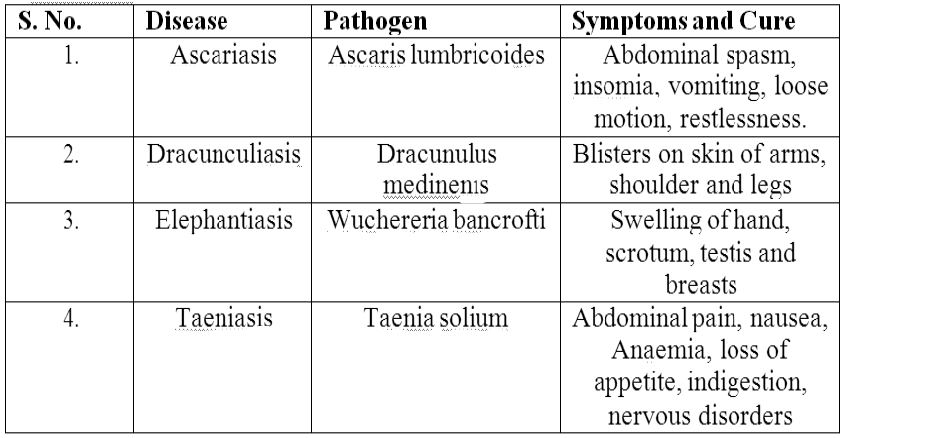
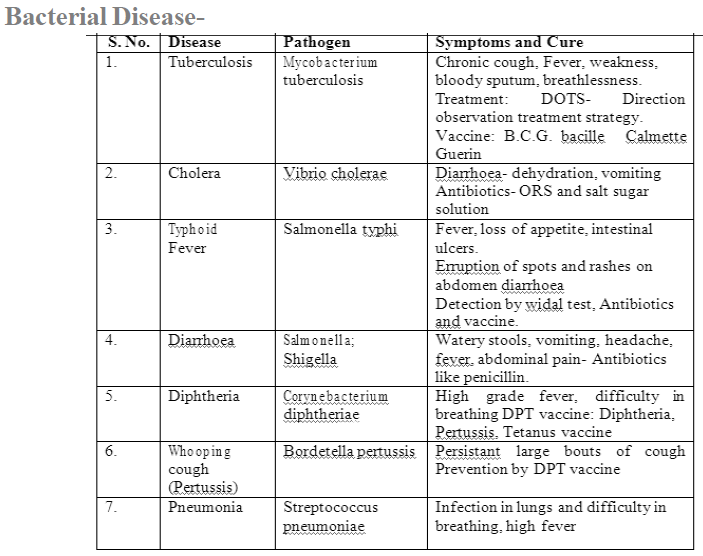
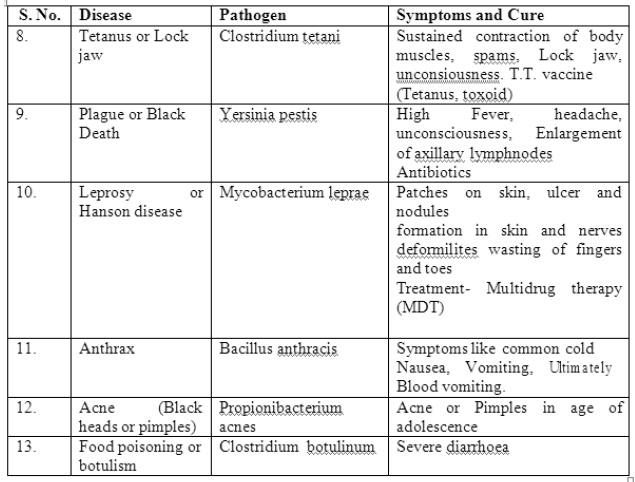
NUTRITIONAL DISORDERS
Balanced Diet :
A balanced diet is the first condition necessary for good health. A balanced diet is one that provides all the nutrients required by the body in correct proportions. The nutrients required by our body are proteins, carbohydrates, fats, vitamins and minerals. When our diet lacks one or more of these nutrients, we get deficiency diseases. For example, if our diet lacks the mineral iron, we may get a disease called anaemia. A balanced diet prevents deficiency disease. It also increases our ability to fight infections in general.
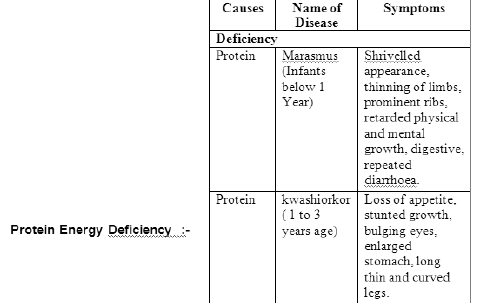
Minerals Deficiency:-
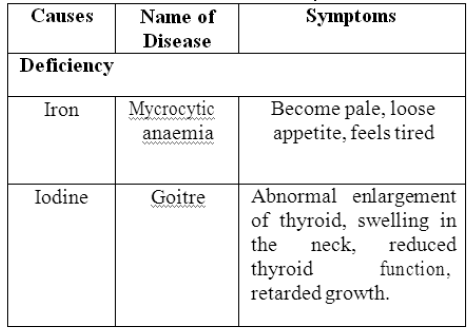
2. Vitamins Deficiency:- Fat –
Soluble vitamins
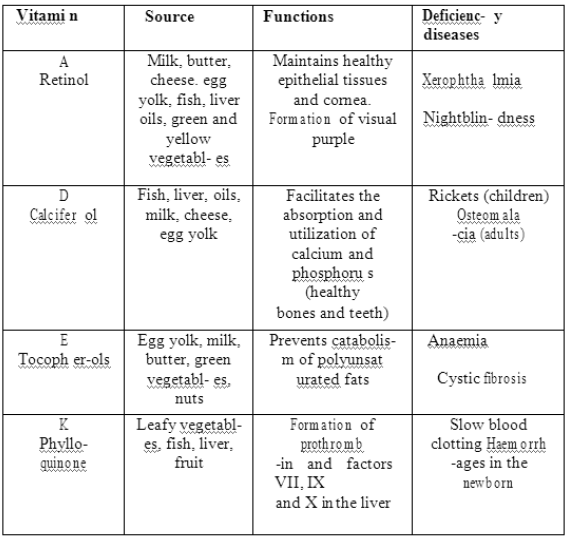
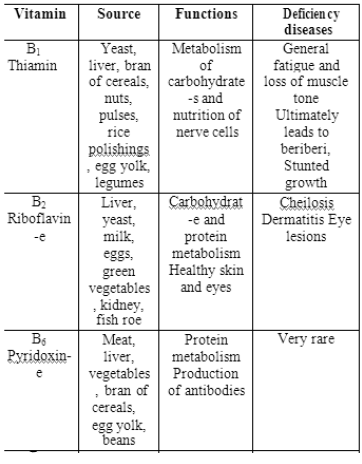
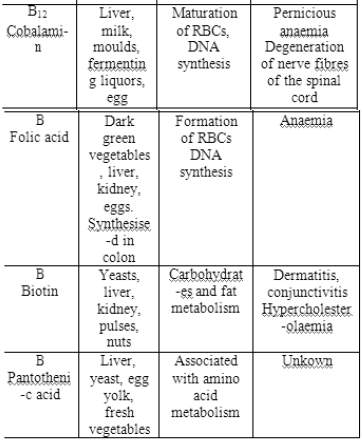
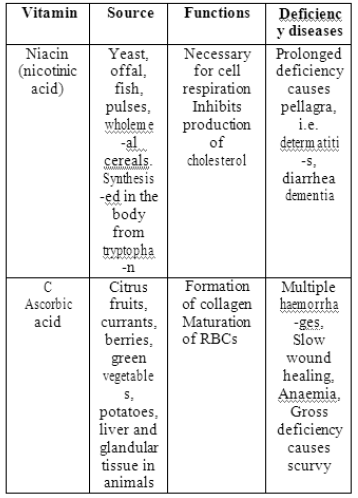
Vaccination :
Jenner took some pus with a sterile needle from the cowpox rash of an infected girl and injected it into scratches made in the skin of an uninfected boy, who soon got cowpox. After he recovered, Jenner injected the boy’s arm with pus from the spots of a person suffering from smallpox. Luckily, the boy did not get smallpox and Jenner’s experiment was successful. The modern term ‘vaccination’ comes from the Latin words vacca which means cow and ‘vaccinia’ which means cow pox. It tells us how Jenner made the first vaccine aganist smallpox using the microbes of cowpox, a similar but less severe disease.
Pulse polio programme :
The pulse polio programme is an immunization drive against polio. Polio is a disease of the muscles and nerves which can cause paralysis. To prevent polio, oral vaccine are given periodically to all children under 5 years of age in our country. This is an effort to eradicate polio, so no child will be infected by the polio virus.
Smallpox vaccine :
An immunization programme was carried out earlier to eradicate smallpox. Earlier, in smallpox epidemics people were afraid of going near someone suffering from it. Smallpox was controlled and eradicated with the help of a vaccine.
Genetic Disease:-
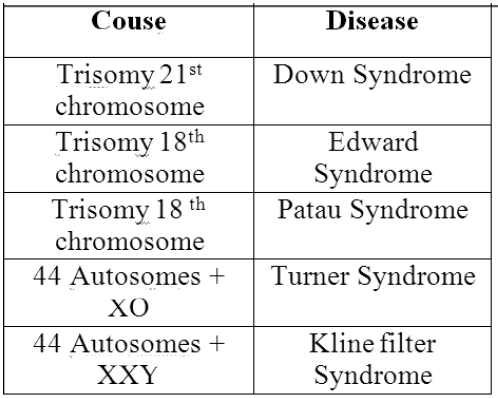
Question: Leprosy is caused due to –
a) Clostridium
b) Salmonella
c) Mycobacterium
d) Bacillus
Answer: c
Question: Tuberculosis is caused by –
a) a bacterium
b) a virus
c) a protozoan
d) AIDS
Answer: a
Question: Breathing polluted air causes diseases of the
a) nervous system
b) circulatory system
c) respiratory system
d) digestive system
Answer: c
Question: Yersinia causes –
a) plague
b) Whoophing cough
c) Leprosy
d) Syphilis
Answer: a
Question: What kind of a disease is arthritis?
a) An acute disease
b) A chronic disease
c) An infectious disease
d) A communicable disease
Answer: b
Question: A type of rhabdovirus causes
a) AIDS
b) TB
c) influenza
d) rabies
Answer: d
Question: Houseflies are the vectors of –
a) cholera
b) malaria
c) dengue
d) cataract
Answer: a
Question: One of the following is the correct match for diseases and causative agents –
a) AIDS – Bacillus
b) Syphilis – Treponema pallidum
c) Malaria – Trypanosoma
d) Gonorrhoea – Virus
Answer: b
Question: Genus Aedes is a vector of –
a) Filaria
b) Dengue
c) Malaria
d) Elephantiasis
Answer: b
Question: Leprosy is also famous as –
a) Koch’s disease
b) Hensen’s disease
c) Pertussis
d) Cholera
Answer: b
Question: Mosquitoes spread –
a) influenza
b) rabies
c) malaria
d) AIDS
Answer: c
Question: Fruit and vegetables bought from the market –
a) may be coated with pesticides
b) may carry germs
c) may carry eggs of worms
d) all the above
Answer: d
Question: Which of the following is due to external causes?
a) Jaundice
b) Diabetes
c) Arthritis
d) Cataract
Answer: a
Question: The infectious agents responsible for which diseases can be spread when the patient coughs?
a) AIDS, TB and hepatitis
b) TB, influenza and cholera
c) TB and influenza
d) TB and hepatitis
Answer: c
Question: Which of the following is not a water borne disease
a) Asthma
b) Cholera
c) Amoebiasis
d) All of the optiona
Answer: a
Question: A healthy person is one who is free from –
a) disease
b) mental tension
c) disease and mental tension
d) bacteria
Answer: c
Question: Which disease is likely to occur in crowded areas?
a) Non-infectious
b) Infectious
c) Genetic
d) Deficiency disease
Answer: b
Question: The diseases that can be transmitted through body fluids are –
a) AIDS and hepatitis B
b) TB and typhoid
c) influenza and cholera
d) cholera and rabies
Answer: a
Question: Sleeping sickness is caused by –
a) Entamoeba
b) Gregarina
c) Trypanosoma
d) Plasmodium
Answer: c
Question: Typhoid fever is caused by –
a) Giardia
b) Salmonella
c) Shigella
d) Escherichia
Answer: b
Question: Anaemia is related to
a) iodine deficiency
b) food adulteration
c) iron deficiency
d) All of the optiona
Answer: c
Question: Endemic disease is caused by –
a) bacteria
b) environment
c) human culture
d) immoral society
Answer: a
Question: The term non-essential amino acid’s is applied to fatty acids that are
a) synthesized in the body
b) water-soluble
c) required by the body but not essential
d) useless
Answer: a
Question: The disease marasmus in children is caused due to the deficiency of –
a) carbohydrates
b) proteins
c) fats
d) vitamins
Answer: b
Question: Ascariasis is a disease caused by –
a) bacteria
b) fungal growth
c) worms
d) none of the options
Answer: c
Question: Which disease has been totally eradicated from India?
a) Plague
b) Small pox
c) Tuberculosis
d) none of the options
Answer: b
Question: The energy produced by 1 g of carbohydrate is
a) 4.6 cal
b) 4.2 kal
c) 9 joules
d) 9.2 kcal
Answer: b
Question: A balanced diet has
a) vegetarian and non-vegetarian dishes
b) salty and sweet dishes
c) carbohydrates, fats and proteins
d) all nutrients, water and roughage
Answer: d
Question: Deformed bones are associated with
a) pellagra
b) beriberi
c) anaemia
d) rickets
Answer: d
Question: Diphtheria is caused by –
a) bacteria
b) virus
c) nematodes
d) fungi
Answer: a
Question: Pick up the set of bacterial diseases –
a) Tetanus, typhoid, tuberculosis
b) Small pox, influenzae, tetanus
c) Meningitis, measles, syphilis
d) none of the options
Answer: a
Question: Gastroenteritis is a disease caused by –
a) virus
b) fungi
c) algae
d) bacteria
Answer: d
Question: An example of an air borne disease from the following is –
a) cholera
b) small pox
c) typhoid
d) AIDS
Answer: b
Question: Which of the following does not spread AIDS by –
a) having sex with unknown person
b) kissing on lips
c) transfusing infected blood
d) taking unsterilized injections
Answer: b
Question: In goitre, there is swelling of the
a) eyes
b) limbs
c) abdomen
d) thyroid gland
Answer: d
Question: Cholesterol is synthesised in
a) Brunner’s
b) Pancreas
c) liver
d) Spleen
Answer: c
Question: Syphilis is an example of –
a) water-borne disease
b) advanced form of jaundice
c) air-borne disease
d) venereal disease
Answer: d
Question: About 70% of our energy requirement should be met by
a) vitamins
b) fats
c) proteins
d) carbohydrates
Answer: d
Question: Kwashiorkor is likely in children who get
a) low-iron diet
b) low-vitamin diet
c) low-fat diet
d) low-protein diet
Answer: d
Question: Vitamins are
a) inorganic substances that cannot be synthesised by animal
b) inorganic substances that can be synthesised by the animal
c) organic substances that cannot be synthesised by animal
d) organic substances that can be synthesised by animal
Answer: c
Question: Vitamin B2 is related with
a) FMN
b) NAD
c) NADH
d) ATP
Answer: a
Question: Cod liver oil is source of
a) vitamin B
b) vitamin C
c) iodine
d) vitamin A
Answer: d
Question: Castle intrinsic factor relates to intestinal absorption of
a) cobalamin
b) thiamine
c) riboflavin
d) pyridoxine
Answer: a
Question: Pernicious anaemia failure of erythrocytes to mature is mainly due to lack of
a) vitamin K
b) thiamine
c) pyridoxine
d) cyanocobal
Answer: d
Question: Vitamin A is responsible for
a) rhodopsin
b) night blindness
c) pellagra
d) cirrhosis
Answer: b
Question: The common housefly is responsible for causing many water-borne diseases. Its role is that of a –
a) carrier
b) vector
c) causative agent
d) none of the options
Answer: b
Question: Botulism is caused by –
a) Salmonella typhae
b) Clostridium botulinum
c) Crasticium botulinum
d) Staphylococci
Answer: b
Question: Which of the following nutrients do not provide energy for animals?
a) Fats
b) Carbohydrates
c) Vitamins
d) Proteins
Answer: c
Question: Insects like cockroach and spider are responsible for food poisoning and diseases. They play the role of a–
a) vector
b) causative agent
c) carrier
d) All of the optiona
Answer: a
Question: Night blindness is due to
a) excessive drinking of alcohol
b) excess secretion of adrenals
c) vitamin A deficiency
d) inheritance by X-chromosome
Answer: c
CBSE Class 7 Science Human And Health Disease Notes
We hope you liked the above notes for topic Human And Health Disease which has been designed as per the latest syllabus for Class 7 Science released by CBSE. Students of Class 7 should download and practice the above notes for Class 7 Science regularly. All revision notes have been designed for Science by referring to the most important topics which the students should learn to get better marks in examinations. Our team of expert teachers have referred to the NCERT book for Class 7 Science to design the Science Class 7 notes. After reading the notes which have been developed as per the latest books also refer to the NCERT solutions for Class 7 Science provided by our teachers. We have also provided a lot of MCQ questions for Class 7 Science in the notes so that you can learn the concepts and also solve questions relating to the topics. We have also provided a lot of Worksheets for Class 7 Science which you can use to further make yourself stronger in Science.
You can download notes for Class 7 Science Human And Health Disease for latest academic session from StudiesToday.com
Yes, the notes issued for Class 7 Science Human And Health Disease have been made available here for latest CBSE session
There is no charge for the notes for CBSE Class 7 Science Human And Health Disease, you can download everything free of charge
www.studiestoday.com is the best website from which you can download latest notes for Human And Health Disease Science Class 7
Come to StudiesToday.com to get best quality topic wise notes for Class 7 Science Human And Health Disease

